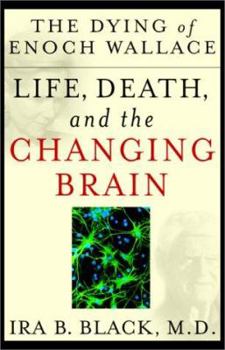The Dying of Enoch Wallace: Life, Death, and the Changing Brain
What happens in the brain when an old dog learns a new trick--or forgets one? As our health care improves and more of us live longer, we see more neurological deficits, from Alzheimer's to stroke;... This description may be from another edition of this product.
Format:Hardcover
Language:English
ISBN:0071362088
ISBN13:9780071362085
Release Date:October 2000
Publisher:McGraw-Hill Companies
Length:260 Pages
Weight:1.32 lbs.
Dimensions:1.0" x 6.2" x 9.2"
Customer Reviews
5 ratings
A MUST READ FOR ANYONE INTERESTED IN BRAIN DISORDERS
Published by Thriftbooks.com User , 23 years ago
This is the best book I've read by far on the human brain -- from both scientific and humanistic perspectives. It's a must read for anyone with a loved one affected by brain disorders. It helps guide you through the human trauma of the degenerative journey of Alzheimers as well as a very broad and informative view of the past and current state of research on the brain.
scientic research and human story
Published by Thriftbooks.com User , 23 years ago
The combination of scientific research laid against the human story of Enoch Wallace ties theory to reality in a profound way.
A hopeful book
Published by Thriftbooks.com User , 23 years ago
The Death of Enoch Wallace is a hopeful book for anyone who has a family member with Alzheimer's disease. It describes, often in painful detail, the initial confusion of finding the right word for things, not remembering the way home, to the more serious functional deterioration in the most fundamental aspects of day-to-day living. Along side is the story of NGF, or Nerve Growth Factor, discovered by Rita Levi-Montalcini over 50 years ago, that sparked a revolution in brain research that has really taken off in the latter part of the 20th century, and continues into the 21st. This is a timely book for me as my mother has been deteriorating from Alzheimer's disease for the past three years. I've been her primary care giver for the past year and a half, and just recently I had to place her in a nursing home. She's in the middle stage of the disease now, often the longest lasting, and the descriptions in the book about Mr. Wallace's symptoms paralleled the one's my mother had. Although Enoch Wallace is not a real person, (as explained in the preface), the symptoms are real, and the confusion and fear that he feels, as well as his family feels, are dead on accurate.The chapter on memory is very good, and the research on grafting cells onto affected brain areas in animals looks promising.When my mother speaks now, it's mostly word salad, but she can answer simple questions with a yes or no - although I'm not sure if she's telling me what she really wants. You guess sometimes. Often she'll be seem to be speaking to someone who isn't there and sometimes her attention will spill over to include me, and for that I'm grateful. I live in hope.
The most common brain deficits explained with optimism
Published by Thriftbooks.com User , 23 years ago
Dr Black employs his talents as a cutting edge researcher to bring both technology and disease to public attention. In simple language he accomplishes this with a clever mix of scientific explanation of brain function and description of common brain diseases. The titled character is a fictitious successful banker in the process of developing Alzheimers and another is afflicted with Parkinsons. Black's dramatic account weaves in symptoms and underlying causative changes as he reviews scientific developments and laboratory experiments. Drawing from many years of training and research at prominent institutions, he reminds us that the human brain is an ever-changing flexible organ the function of which constitutes the amazing plastic mind. The brain, previously considered a relatively static and non-renewable assembly of nerve cells, is described as a very dynamic structure whose growth factors convert experience into intercellular connections which mediate learning, memory and emotion. He suggests that new discoveries mark only the beginning of understanding, not only with respect to possible cellular transplantation but also with respect to replication of existing cells to replace dying cells of the diseased brain.
A brilliant book!!!
Published by Thriftbooks.com User , 23 years ago
Ira Black paints a moving portrait of an elderly gentleman suffering from Alzheimer's disease. A disease that too many people whom we love, suffer from. I found myself gripped by this story of Enoch Wallace's battle with the illness. In riveting detail Dr. Black walks us through Wallace's downfall. It is interspersed with up-to-the-minute scientific details that explain what's actually happening in Wallace's brain. This is a moving, must read book for anyone interested in science, or who has ever known someone who suffers from Alzheimer's disease.





